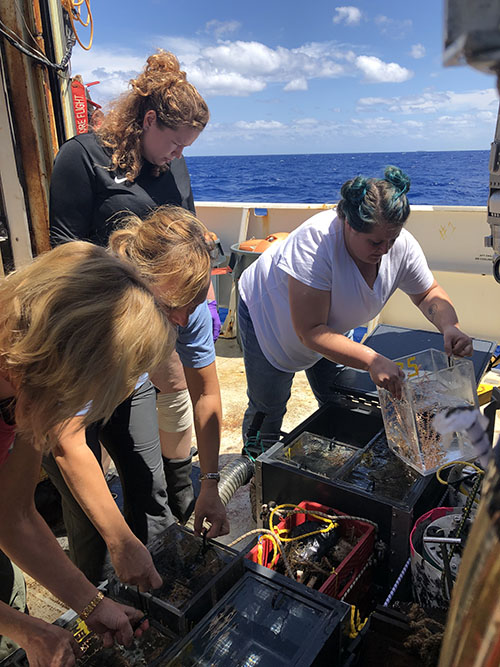
By Alexis Weinnig, PhD Candidate, Temple University

ROV Jason is equipped with a sample “basket” that can be fitted with specific sampling equipment provided by the science team. Here, the ROV pilot places a snip of Lophelia pertusa into a biobox, which is an insulated housing designed to keep the corals with the cold water they’re collected in for the duration of the ROV dive. Image courtesy of Ivan Hurzeler and DEEP SEARCH 2019 - BOEM, USGS, NOAA, ROV Jason, ©Woods Hole Oceanographic Institution. Download larger version (jpg, 4.7 MB).
When we send a remotely operated vehicle (ROV) like Jason down into the ocean it not only provides us eyes on the seafloor with cameras but also arms with hydraulic manipulators. These manipulators provide a lot of utility to sample in different ways while on the seafloor. Generally, one manipulator has a claw-like hand that works well for picking up push cores (to sample sediment) and other more coarse operations. The other manipulator has a hand with a set of blades known as “coral cutters” that allow for precise and non-destructive sampling of delicate coral colonies. Throughout our sites we are sampling snips (3-6 inches) of corals and associated fauna for genetic and isotopic (food web) analysis, as well as collecting scleractinian (stony) corals for live coral experiments.

One of ROV Jason’s manipulator arms is equipped with a set of blades known as “coral cutters” that are used to precisely and non-destructively sample delicate coral colonies. Image courtesy of Ivan Hurzeler and DEEP SEARCH 2019 - BOEM, USGS, NOAA, ROV Jason, ©Woods Hole Oceanographic Institution. Download larger version (jpg, 4.6 MB).
My PhD advisor, Erik Cordes, and I are collecting scleractinian corals from depths of about 700 meters with the intention of running live coral experiments once we get back to the lab at Temple University. Once we collect the corals with the ROV, we keep them alive onboard the ship in cold seawater collected from their natural habitat using the CTD rosette’s Niskin bottles. Then when we return to port at the end of the cruise, we will ship them back to Temple in refrigerated containers and maintain them in a saltwater aquarium until we’re ready to begin experiments. We typically are able to keep corals alive and healthy in the lab for 3-6 months while we’re studying them. Unlike some other deep-sea animals, corals do not need to be kept at the same high pressures they’re used to on the seafloor and can thrive at sea-level. For the purposes of the DEEP SEARCH project, the coral we’re targeting for live experiments is Lophelia pertusa. Lophelia is a colonial stony coral—meaning that each polyp is an individual animal that over time excretes and grows the hard calcium carbonate skeleton that the live coral tissue covers. These corals are not only animals themselves, but they provide habitat, food, and nursery space for many other invertebrates and fishes.

Alexis Weinnig (right) lifts one of the clear plastic inserts out of the biobox on ROV Jason’s sample basket. When the ROV comes to the surface, all corals are quickly transported to the ship’s cold room, where they’ll be kept until the end of the cruise. Image courtesy of DEEP SEARCH 2019 - BOEM, USGS, NOAA. Download larger version (jpg, 5 MB).
Back in our lab, we will be running a suite of experiments to better understand how these corals physically respond to changes in their environment. We’re able to fully control the conditions (temperature, oxygen, pH, food availability, etc.) in our lab aquaria, and we can measure how the corals respond to changes in those conditions. How well these corals perform under different environmental conditions is particularly interesting because of their proximity to the Gulf Stream, which runs above and across these large scleractinian coral habitats. Does the environmental variability driven by the Gulf Stream induce stress responses in the corals, or are they able to utilize this variability to their advantage? Assessing coral respiration, excretion, food uptake, and other physiological variables will provide valuable insight into answering this question. These experiments will also shed light on coral physiology under the current conditions, providing a baseline for monitoring as climate change advances and environmental conditions vary.